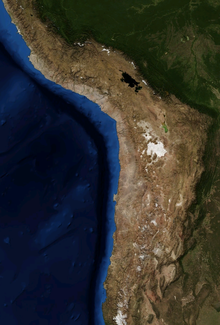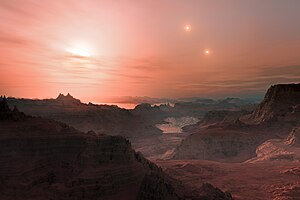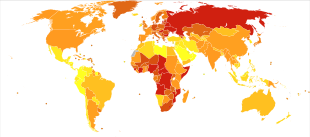Planetary habitability is the measure of a planet's or a natural satellite's potential to develop and maintain environments hospitable to life. Life may be generated directly on a planet or satellite endogenously or be transferred to it from another body, a hypothetical process known as panspermia. Environments do not need to contain life to be considered habitable nor are accepted habitable zones the only areas in which life might arise.
As the existence of life beyond Earth is unknown, planetary habitability is largely an extrapolation of conditions on Earth and the characteristics of the Sun and Solar System which appear favorable to life's flourishing. Of particular interest are those factors that have sustained complex, multicellular organisms on Earth and not just simpler, unicellular creatures. Research and theory in this regard is a component of a number of natural sciences, such as astronomy, planetary science and the emerging discipline of astrobiology.
An absolute requirement for life is an energy source, and the notion of planetary habitability implies that many other geophysical, geochemical, and astrophysical criteria must be met before an astronomical body can support life. In its astrobiology roadmap, NASA has defined the principal habitability criteria as "extended regions of liquid water, conditions favorable for the assembly of complex organic molecules, and energy sources to sustain metabolism". In August 2018, researchers reported that water worlds could support life.
Habitability indicators and biosignatures must be interpreted within a planetary and environmental context. In determining the habitability potential of a body, studies focus on its bulk composition, orbital properties, atmosphere, and potential chemical interactions. Stellar characteristics of importance include mass and luminosity, stable variability, and high metallicity. Rocky, wet terrestrial-type planets and moons with the potential for Earth-like chemistry are a primary focus of astrobiological research, although more speculative habitability theories occasionally examine alternative biochemistries and other types of astronomical bodies.
The idea that planets beyond Earth might host life is an ancient one, though historically it was framed by philosophy as much as physical science. The late 20th century saw two breakthroughs in the field. The observation and robotic spacecraft exploration
of other planets and moons within the Solar System has provided
critical information on defining habitability criteria and allowed for
substantial geophysical comparisons between the Earth and other bodies.
The discovery of extrasolar planets, beginning in the early 1990s
and accelerating thereafter, has provided further information for the
study of possible extraterrestrial life. These findings confirm that the
Sun is not unique among stars in hosting planets and expands the habitability research horizon beyond the Solar System.
Earth habitability comparison
The chemistry of life may have begun shortly after the Big Bang, 13.8 billion years ago, during a habitable epoch when the Universe was only 10–17 million years old. According to the panspermia hypothesis, microscopic life—distributed by meteoroids, asteroids and other small Solar System bodies—may exist throughout the Universe. Nonetheless, Earth is the only place in the Universe known to harbor life. Estimates of habitable zones around other stars, along with the discovery of hundreds of extrasolar planets
and new insights into the extreme habitats here on Earth, suggest that
there may be many more habitable places in the Universe than considered
possible until very recently. On 4 November 2013, astronomers reported, based on Kepler space mission data, that there could be as many as 40 billion Earth-sized planets orbiting in the habitable zones of Sun-like stars and red dwarfs within the Milky Way. 11 billion of these estimated planets may be orbiting Sun-like stars. The nearest such planet may be 12 light-years away, according to the scientists.
Suitable star systems
An understanding of planetary habitability begins with the host star.
The classical HZ is defined for surface conditions only; but a
metabolism that does not depend on the stellar light, can still exist
outside the HZ, thriving in the interior of the planet where liquid
water is available.
Under the auspices of SETI's Project Phoenix, scientists Margaret Turnbull and Jill Tarter developed the "HabCat"
(or Catalogue of Habitable Stellar Systems) in 2002. The catalogue was
formed by winnowing the nearly 120,000 stars of the larger Hipparcos Catalogue
into a core group of 17,000 potentially habitable stars, and the
selection criteria that were used provide a good starting point for
understanding which astrophysical factors are necessary to habitable
planets.
According to research published in August 2015, very large galaxies may
be more favorable to the formation and development of habitable planets
than smaller galaxies, like the Milky Way galaxy.
However, the question of what makes a planet habitable is much
more complex than having a planet located at the right distance from its
host star so that water can be liquid on its surface: various geophysical and geodynamical aspects, the radiation, and the host star's plasma environment can influence the evolution of planets and life, if it originated.
Liquid water is a necessary but not sufficient condition for life as we
know it, as habitability is a function of a multitude of environmental
parameters.
Spectral class
The spectral class of a star indicates its photospheric temperature, which (for main-sequence stars)
correlates to overall mass. The appropriate spectral range for
habitable stars is considered to be "late F" or "G", to "mid-K". This
corresponds to temperatures of a little more than 7,000 K
down to a little less than 4,000 K (6,700 °C to 3,700 °C); the Sun, a
G2 star at 5,777 K, is well within these bounds. This spectral range
probably accounts for between 5% and 10% of stars in the local Milky Way galaxy. "Middle-class" stars of this sort have a number of characteristics considered important to planetary habitability:
- They live at least a few billion years, allowing life a chance to evolve. More luminous main-sequence stars of the "O", "B", and "A" classes usually live less than a billion years and in exceptional cases less than 10 million.
- They emit enough high-frequency ultraviolet radiation to trigger important atmospheric dynamics such as ozone formation, but not so much that ionisation destroys incipient life.
- They emit sufficient radiation at wavelengths conducive to photosynthesis.
- Liquid water may exist on the surface of planets orbiting them at a distance that does not induce tidal locking.
K-type stars may be able to support life far longer than the Sun.
Whether fainter late K and M class red dwarf
stars are also suitable hosts for habitable planets is perhaps the most
important open question in the entire field of planetary habitability
given their prevalence (habitability of red dwarf systems). Gliese 581 c, a "super-Earth", has been found orbiting in the "habitable zone" (HZ) of a red dwarf
and may possess liquid water. However it is also possible that a
greenhouse effect may render it too hot to support life, while its
neighbor, Gliese 581 d, may be a more likely candidate for habitability. In September 2010, the discovery was announced of another planet, Gliese 581 g,
in an orbit between these two planets. However, reviews of the
discovery have placed the existence of this planet in doubt, and it is
listed as "unconfirmed". In September 2012, the discovery of two planets
orbiting Gliese 163 was announced. One of the planets, Gliese 163 c, about 6.9 times the mass of Earth and somewhat hotter, was considered to be within the habitable zone.
A recent study suggests that cooler stars that emit more light in
the infrared and near infrared may actually host warmer planets with
less ice and incidence of snowball states. These wavelengths are
absorbed by their planets' ice and greenhouse gases and remain warmer.
A stable habitable zone
The habitable zone (HZ) is a shell-shaped region of space surrounding a star in which a planet could maintain liquid water on its surface. The concept was first proposed by astrophysicist Su-Shu Huang in 1959, based on climatic constraints imposed by the host star.
After an energy source, liquid water is considered the most important
ingredient for life, considering how integral it is to all life systems
on Earth. This may reflect the known dependence of life on water;
however, if life is discovered in the absence of water, the definition
of an HZ may have to be greatly expanded.
The inner edge of the HZ is the distance where runaway greenhouse effect
vaporize the whole water reservoir and, as a second effect, induce the
photodissociation of water vapor and the loss of hydrogen to space. The
outer edge of the HZ is the distance from the star where a maximum
greenhouse effect fails to keep the surface of the planet above the
freezing point, and by CO
2 condensation.
2 condensation.
A "stable" HZ implies two factors. First, the range of an HZ
should not vary greatly over time. All stars increase in luminosity as
they age, and a given HZ thus migrates outwards, but if this happens too
quickly (for example, with a super-massive star) planets may only have a
brief window inside the HZ and a correspondingly smaller chance of
developing life. Calculating an HZ range and its long-term movement is
never straightforward, as negative feedback loops such as the CNO cycle
will tend to offset the increases in luminosity. Assumptions made about
atmospheric conditions and geology thus have as great an impact on a
putative HZ range as does stellar evolution: the proposed parameters of
the Sun's HZ, for example, have fluctuated greatly.
Second, no large-mass body such as a gas giant
should be present in or relatively close to the HZ, thus disrupting the
formation of Earth-size bodies. The matter in the asteroid belt, for
example, appears to have been unable to accrete into a planet due to
orbital resonances with Jupiter; if the giant had appeared in the region
that is now between the orbits of Venus and Mars, Earth would almost certainly not have developed in its present form. However a gas giant inside the HZ might have habitable moons under the right conditions.
In the Solar System, the inner planets are terrestrial, and the outer ones are gas giants, but discoveries of extrasolar planets
suggest that this arrangement may not be at all common: numerous
Jupiter-sized bodies have been found in close orbit about their primary,
disrupting potential HZs. However, present data for extrasolar planets
is likely to be skewed towards that type (large planets in close orbits)
because they are far easier to identify; thus it remains to be seen
which type of planetary system is the norm, or indeed if there is one.
Low stellar variation
Changes in luminosity
are common to all stars, but the severity of such fluctuations covers a
broad range. Most stars are relatively stable, but a significant
minority of variable stars often undergo sudden and intense increases in
luminosity and consequently in the amount of energy radiated toward
bodies in orbit. These stars are considered poor candidates for hosting
life-bearing planets, as their unpredictability and energy output
changes would negatively impact organisms:
living things adapted to a specific temperature range could not survive
too great a temperature variation. Further, upswings in luminosity are
generally accompanied by massive doses of gamma ray and X-ray radiation which might prove lethal. Atmospheres
do mitigate such effects, but their atmosphere might not be retained by
planets orbiting variables, because the high-frequency energy buffeting
these planets would continually strip them of their protective
covering.
The Sun, in this respect as in many others, is relatively benign:
the variation between its maximum and minimum energy output is roughly
0.1% over its 11-year solar cycle. There is strong (though not undisputed) evidence
that even minor changes in the Sun's luminosity have had significant
effects on the Earth's climate well within the historical era: the Little Ice Age of the mid-second millennium, for instance, may have been caused by a relatively long-term decline in the Sun's luminosity. Thus, a star does not have to be a true variable for differences in luminosity to affect habitability. Of known solar analogs, one that closely resembles the Sun is considered to be 18 Scorpii;
unfortunately for the prospects of life existing in its proximity, the
only significant difference between the two bodies is the amplitude of
the solar cycle, which appears to be much greater for 18 Scorpii.
High metallicity
While the bulk of material in any star is hydrogen and helium, there is a significant variation in the amount of heavier elements (metals). A high proportion of metals in a star correlates to the amount of heavy material initially available in the protoplanetary disk. A smaller amount of metal makes the formation of planets much less likely, under the solar nebula theory of planetary system formation. Any planets that did form around a metal-poor star would probably be low in mass, and thus unfavorable for life. Spectroscopic studies of systems where exoplanets
have been found to date confirm the relationship between high metal
content and planet formation: "Stars with planets, or at least with
planets similar to the ones we are finding today, are clearly more metal
rich than stars without planetary companions."
This relationship between high metallicity and planet formation also
means that habitable systems are more likely to be found around stars of
younger generations, since stars that formed early in the universe's history have low metal content.
Planetary characteristics
The moons of some gas giants could potentially be habitable.
Habitability indicators and biosignatures must be interpreted within a planetary and environmental context.
Whether a planet will emerge as habitable depends on the sequence of
events that led to its formation, which could include the production of
organic molecules in molecular clouds and protoplanetary disks, delivery of materials during and after planetary accretion, and the orbital location in the planetary system. The chief assumption about habitable planets is that they are terrestrial. Such planets, roughly within one order of magnitude of Earth mass, are primarily composed of silicate rocks, and have not accreted the gaseous outer layers of hydrogen and helium found on gas giants. The possibility that life could evolve in the cloud tops of giant planets has not been decisively ruled out, though it is considered unlikely, as they have no surface and their gravity is enormous. The natural satellites of giant planets, meanwhile, remain valid candidates for hosting life.
In February 2011 the Kepler Space Observatory Mission team released a list of 1235 extrasolar planet candidates, including 54 that may be in the habitable zone. Six of the candidates in this zone are smaller than twice the size of Earth. A more recent study found that one of these candidates (KOI 326.01) is much larger and hotter than first reported.
Based on the findings, the Kepler team estimated there to be "at least
50 billion planets in the Milky Way" of which "at least 500 million" are
in the habitable zone.
In analyzing which environments are likely to support life, a
distinction is usually made between simple, unicellular organisms such
as bacteria and archaea
and complex metazoans (animals). Unicellularity necessarily precedes
multicellularity in any hypothetical tree of life, and where
single-celled organisms do emerge there is no assurance that greater
complexity will then develop.
The planetary characteristics listed below are considered crucial for
life generally, but in every case multicellular organisms are more picky
than unicellular life.
Mass
Low-mass planets are poor candidates for life for two reasons. First, their lesser gravity makes atmosphere retention difficult. Constituent molecules are more likely to reach escape velocity and be lost to space when buffeted by solar wind or stirred by collision. Planets without a thick atmosphere lack the matter necessary for primal biochemistry, have little insulation and poor heat transfer across their surfaces (for example, Mars,
with its thin atmosphere, is colder than the Earth would be if it were
at a similar distance from the Sun), and provide less protection against
meteoroids and high-frequency radiation. Further, where an atmosphere is less dense than 0.006 Earth atmospheres, water cannot exist in liquid form as the required atmospheric pressure, 4.56 mm Hg (608 Pa) (0.18 inch Hg), does not occur. The temperature range at which water is liquid is smaller at low pressures generally.
Secondly, smaller planets have smaller diameters
and thus higher surface-to-volume ratios than their larger cousins.
Such bodies tend to lose the energy left over from their formation
quickly and end up geologically dead, lacking the volcanoes, earthquakes and tectonic activity which supply the surface with life-sustaining material and the atmosphere with temperature moderators like carbon dioxide.
Plate tectonics appear particularly crucial, at least on Earth: not
only does the process recycle important chemicals and minerals, it also
fosters bio-diversity through continent creation and increased environmental complexity and helps create the convective cells necessary to generate Earth's magnetic field.
"Low mass" is partly a relative label: the Earth is low mass when compared to the Solar System's gas giants, but it is the largest, by diameter and mass, and the densest of all terrestrial bodies.
It is large enough to retain an atmosphere through gravity alone and
large enough that its molten core remains a heat engine, driving the
diverse geology of the surface (the decay of radioactive
elements within a planet's core is the other significant component of
planetary heating). Mars, by contrast, is nearly (or perhaps totally)
geologically dead and has lost much of its atmosphere.
Thus it would be fair to infer that the lower mass limit for
habitability lies somewhere between that of Mars and that of Earth or
Venus: 0.3 Earth masses has been offered as a rough dividing line for
habitable planets.
However, a 2008 study by the Harvard-Smithsonian Center for
Astrophysics suggests that the dividing line may be higher. Earth may in
fact lie on the lower boundary of habitability: if it were any smaller,
plate tectonics would be impossible. Venus, which has 85% of Earth's
mass, shows no signs of tectonic activity. Conversely, "super-Earths",
terrestrial planets with higher masses than Earth, would have higher
levels of plate tectonics and thus be firmly placed in the habitable
range.
Exceptional circumstances do offer exceptional cases: Jupiter's moon Io
(which is smaller than any of the terrestrial planets) is volcanically
dynamic because of the gravitational stresses induced by its orbit, and
its neighbor Europa may have a liquid ocean or icy slush underneath a frozen shell also due to power generated from orbiting a gas giant.
Saturn's Titan,
meanwhile, has an outside chance of harbouring life, as it has retained
a thick atmosphere and has liquid methane seas on its surface.
Organic-chemical reactions that only require minimum energy are possible
in these seas, but whether any living system can be based on such
minimal reactions is unclear, and would seem unlikely. These satellites
are exceptions, but they prove that mass, as a criterion for
habitability, cannot necessarily be considered definitive at this stage
of our understanding.
A larger planet is likely to have a more massive atmosphere. A
combination of higher escape velocity to retain lighter atoms, and
extensive outgassing from enhanced plate tectonics may greatly increase
the atmospheric pressure and temperature at the surface compared to
Earth. The enhanced greenhouse effect of such a heavy atmosphere would
tend to suggest that the habitable zone should be further out from the
central star for such massive planets.
Finally, a larger planet is likely to have a large iron core. This allows for a magnetic field to protect the planet from stellar wind and cosmic radiation,
which otherwise would tend to strip away planetary atmosphere and to
bombard living things with ionized particles. Mass is not the only
criterion for producing a magnetic field—as the planet must also rotate
fast enough to produce a dynamo effect within its core—but it is a significant component of the process.
Orbit and rotation
As
with other criteria, stability is the critical consideration in
evaluating the effect of orbital and rotational characteristics on
planetary habitability. Orbital eccentricity
is the difference between a planet's farthest and closest approach to
its parent star divided by the sum of said distances. It is a ratio
describing the shape of the elliptical orbit. The greater the
eccentricity the greater the temperature fluctuation on a planet's
surface. Although they are adaptive, living organisms can stand only so
much variation, particularly if the fluctuations overlap both the freezing point and boiling point
of the planet's main biotic solvent (e.g., water on Earth). If, for
example, Earth's oceans were alternately boiling and freezing solid, it
is difficult to imagine life as we know it having evolved. The more
complex the organism, the greater the temperature sensitivity.
The Earth's orbit is almost perfectly circular, with an eccentricity of
less than 0.02; other planets in the Solar System (with the exception
of Mercury) have eccentricities that are similarly benign.
Habitability is also influenced by the architecture of the
planetary system around a star. The evolution and stability of these
systems are determined by gravitational dynamics, which drive the
orbital evolution of terrestrial planets. Data collected on the orbital
eccentricities of extrasolar planets has surprised most researchers:
90% have an orbital eccentricity greater than that found within the
Solar System, and the average is fully 0.25.
This means that the vast majority of planets have highly eccentric
orbits and of these, even if their average distance from their star is
deemed to be within the HZ, they nonetheless would be spending only a
small portion of their time within the zone.
A planet's movement around its rotational axis
must also meet certain criteria if life is to have the opportunity to
evolve. A first assumption is that the planet should have moderate seasons. If there is little or no axial tilt (or obliquity) relative to the perpendicular of the ecliptic,
seasons will not occur and a main stimulant to biospheric dynamism will
disappear. The planet would also be colder than it would be with a
significant tilt: when the greatest intensity of radiation is always
within a few degrees of the equator, warm weather cannot move poleward
and a planet's climate becomes dominated by colder polar weather
systems.
If a planet is radically tilted, seasons will be extreme and make it more difficult for a biosphere to achieve homeostasis. The axial tilt of the Earth is higher now (in the Quaternary) than it has been in the past, coinciding with reduced polar ice, warmer temperatures and less
seasonal variation. Scientists do not know whether this trend will
continue indefinitely with further increases in axial tilt.
The exact effects of these changes can only be computer modelled
at present, and studies have shown that even extreme tilts of up to 85
degrees do not absolutely preclude life "provided it does not occupy
continental surfaces plagued seasonally by the highest temperature."
Not only the mean axial tilt, but also its variation over time must be
considered. The Earth's tilt varies between 21.5 and 24.5 degrees over
41,000 years. A more drastic variation, or a much shorter periodicity,
would induce climatic effects such as variations in seasonal severity.
Other orbital considerations include:
- The planet should rotate relatively quickly so that the day-night cycle is not overlong. If a day takes years, the temperature differential between the day and night side will be pronounced, and problems similar to those noted with extreme orbital eccentricity will come to the fore.
- The planet also should rotate quickly enough so that a magnetic dynamo may be started in its iron core to produce a magnetic field.
- Change in the direction of the axis rotation (precession) should not be pronounced. In itself, precession need not affect habitability as it changes the direction of the tilt, not its degree. However, precession tends to accentuate variations caused by other orbital deviations; see Milankovitch cycles. Precession on Earth occurs over a 26,000-year cycle.
The Earth's Moon appears to play a crucial role
in moderating the Earth's climate by stabilising the axial tilt. It has
been suggested that a chaotic tilt may be a "deal-breaker" in terms of
habitability—i.e. a satellite the size of the Moon is not only helpful
but required to produce stability. This position remains controversial.
In the case of the Earth, the sole Moon is sufficiently massive and orbits so as to significantly contribute to ocean tides,
which in turn aids the dynamic churning of Earth's large liquid water
oceans. These lunar forces not only help ensure that the oceans do not
stagnate, but also play a critical role in Earth's dynamic climate.
Geochemistry
It is generally assumed that any extraterrestrial life that might exist will be based on the same fundamental biochemistry as found on Earth, as the four elements most vital for life, carbon, hydrogen, oxygen, and nitrogen, are also the most common chemically reactive elements in the universe. Indeed, simple biogenic compounds, such as very simple amino acids such as glycine, have been found in meteorites and in the interstellar medium. These four elements together comprise over 96% of Earth's collective biomass.
Carbon has an unparalleled ability to bond with itself and to form a
massive array of intricate and varied structures, making it an ideal
material for the complex mechanisms that form living cells.
Hydrogen and oxygen, in the form of water, compose the solvent in which
biological processes take place and in which the first reactions
occurred that led to life's emergence. The energy released in the formation of powerful covalent bonds
between carbon and oxygen, available by oxidizing organic compounds, is
the fuel of all complex life-forms. These four elements together make
up amino acids, which in turn are the building blocks of proteins, the substance of living tissue. In addition, neither sulfur, required for the building of proteins, nor phosphorus, needed for the formation of DNA, RNA, and the adenosine phosphates essential to metabolism, is rare.
Relative abundance in space does not always mirror differentiated
abundance within planets; of the four life elements, for instance, only
oxygen is present in any abundance in the Earth's crust. This can be partly explained by the fact that many of these elements, such as hydrogen and nitrogen, along with their simplest and most common compounds, such as carbon dioxide, carbon monoxide, methane, ammonia,
and water, are gaseous at warm temperatures. In the hot region close to
the Sun, these volatile compounds could not have played a significant
role in the planets' geological formation. Instead, they were trapped as
gases underneath the newly formed crusts, which were largely made of
rocky, involatile compounds such as silica (a compound of silicon and oxygen, accounting for oxygen's relative abundance). Outgassing of volatile compounds through the first volcanoes would have contributed to the formation of the planets' atmospheres. The Miller–Urey experiment
showed that, with the application of energy, simple inorganic compounds
exposed to a primordial atmosphere can react to synthesize amino acids.
Even so, volcanic outgassing could not have accounted for the amount of water in Earth's oceans.
The vast majority of the water —and arguably carbon— necessary for life
must have come from the outer Solar System, away from the Sun's heat,
where it could remain solid. Comets
impacting with the Earth in the Solar System's early years would have
deposited vast amounts of water, along with the other volatile compounds
life requires onto the early Earth, providing a kick-start to the origin of life.
Thus, while there is reason to suspect that the four "life
elements" ought to be readily available elsewhere, a habitable system
probably also requires a supply of long-term orbiting bodies to seed
inner planets. Without comets there is a possibility that life as we
know it would not exist on Earth.
Microenvironments and extremophiles
The Atacama Desert in South America provides an analog to Mars and an ideal environment to study the boundary between sterility and habitability.
One important qualification to habitability criteria is that only a
tiny portion of a planet is required to support life. Astrobiologists
often concern themselves with "micro-environments", noting that "we lack
a fundamental understanding of how evolutionary forces, such as mutation, selection, and genetic drift, operate in micro-organisms that act on and respond to changing micro-environments." Extremophiles are Earth organisms that live in niche environments under severe conditions generally considered inimical to life. Usually (although not always) unicellular, extremophiles include acutely alkaliphilic and acidophilic organisms and others that can survive water temperatures above 100 °C in hydrothermal vents.
The discovery of life in extreme conditions has complicated
definitions of habitability, but also generated much excitement amongst
researchers in greatly broadening the known range of conditions under
which life can persist. For example, a planet that might otherwise be
unable to support an atmosphere given the solar conditions in its
vicinity, might be able to do so within a deep shadowed rift or volcanic
cave. Similarly, craterous terrain might offer a refuge for primitive life. The Lawn Hill crater
has been studied as an astrobiological analog, with researchers
suggesting rapid sediment infill created a protected microenvironment
for microbial organisms; similar conditions may have occurred over the
geological history of Mars.
Earth environments that cannot support life are still instructive to astrobiologists in defining the limits of what organisms can endure. The heart of the Atacama desert, generally considered the driest place on Earth, appears unable to support life, and it has been subject to study by NASA and ESA
for that reason: it provides a Mars analog and the moisture gradients
along its edges are ideal for studying the boundary between sterility
and habitability. The Atacama was the subject of study in 2003 that partly replicated experiments from the Viking landings on Mars in the 1970s; no DNA could be recovered from two soil samples, and incubation experiments were also negative for biosignatures.
Ecological factors
The
two current ecological approaches for predicting the potential
habitability use 19 or 20 environmental factors, with emphasis on water
availability, temperature, presence of nutrients, an energy source, and
protection from solar ultraviolet and galactic cosmic radiation.
| Some habitability factors | |
|---|---|
| Water | · Activity of liquid water · Past or future liquid (ice) inventories · Salinity, pH, and Eh of available water |
| Chemical environment | Nutrients: · C, H, N, O, P, S, essential metals, essential micronutrients · Fixed nitrogen · Availability/mineralogy Toxin abundances and lethality: · Heavy metals (e.g. Zn, Ni, Cu, Cr, As, Cd, etc.; some are essential, but toxic at high levels) · Globally distributed oxidizing soils |
| Energy for metabolism | Solar (surface and near-surface only) Geochemical (subsurface) · Oxidants · Reductants · Redox gradients |
| Conducive physical conditions |
· Temperature · Extreme diurnal temperature fluctuations · Low pressure (is there a low-pressure threshold for terrestrial anaerobes?) · Strong ultraviolet germicidal irradiation · Galactic cosmic radiation and solar particle events (long-term accumulated effects) · Solar UV-induced volatile oxidants, e.g. O 2−, O−, H2O2, O3 · Climate and its variability (geography, seasons, diurnal, and eventually, obliquity variations) · Substrate (soil processes, rock microenvironments, dust composition, shielding) · High CO2 concentrations in the global atmosphere · Transport (aeolian, ground water flow, surface water, glacial) |
Alternative star systems
In
determining the feasibility of extraterrestrial life, astronomers had
long focused their attention on stars like the Sun. However, since
planetary systems that resemble the Solar System are proving to be rare,
they have begun to explore the possibility that life might form in
systems very unlike our own.
Binary systems
Typical estimates often suggest that 50% or more of all stellar systems are binary systems.
This may be partly sample bias, as massive and bright stars tend to be
in binaries and these are most easily observed and catalogued; a more
precise analysis has suggested that the more common fainter stars are
usually singular, and that up to two thirds of all stellar systems are
therefore solitary.
The separation between stars in a binary may range from less than one astronomical unit
(AU, the average Earth–Sun distance) to several hundred. In latter
instances, the gravitational effects will be negligible on a planet
orbiting an otherwise suitable star and habitability potential will not
be disrupted unless the orbit is highly eccentric. However, where the separation is significantly less, a
stable orbit may be impossible. If a planet's distance to its primary
exceeds about one fifth of the closest approach of the other star,
orbital stability is not guaranteed.
Whether planets might form in binaries at all had long been unclear,
given that gravitational forces might interfere with planet formation.
Theoretical work by Alan Boss at the Carnegie Institution has shown that gas giants can form around stars in binary systems much as they do around solitary stars.
One study of Alpha Centauri,
the nearest star system to the Sun, suggested that binaries need not be
discounted in the search for habitable planets. Centauri A and B have
an 11 AU distance at closest approach (23 AU mean), and both should have
stable habitable zones. A study of long-term orbital stability for
simulated planets within the system shows that planets within
approximately three AU of either star may remain rather stable (i.e. the
semi-major axis
deviating by less than 5% during 32 000 binary periods). The HZ for
Centauri A is conservatively estimated at 1.2 to 1.3 AU and Centauri B at 0.73 to 0.74—well within the stable region in both cases.
Red dwarf systems
Relative star sizes and photospheric temperatures. Any planet around a red dwarf such as the one shown here (Gliese 229A) would have to huddle close to achieve Earth-like temperatures, probably inducing tidal locking. See Aurelia. Credit: MPIA/V. Joergens.
Determining the habitability of red dwarf
stars could help determine how common life in the universe might be, as
red dwarfs make up between 70 and 90% of all the stars in the galaxy.
Size
Astronomers
for many years ruled out red dwarfs as potential abodes for life. Their
small size (from 0.08 to 0.45 solar masses) means that their nuclear reactions
proceed exceptionally slowly, and they emit very little light (from 3%
of that produced by the Sun to as little as 0.01%). Any planet in orbit
around a red dwarf would have to huddle very close to its parent star to
attain Earth-like surface temperatures; from 0.3 AU (just inside the
orbit of Mercury) for a star like Lacaille 8760, to as little as 0.032 AU for a star like Proxima Centauri
(such a world would have a year lasting just 6.3 days). At those
distances, the star's gravity would cause tidal locking. One side of the
planet would eternally face the star, while the other would always face
away from it. The only ways in which potential life could avoid either
an inferno or a deep freeze would be if the planet had an atmosphere
thick enough to transfer the star's heat from the day side to the night
side, or if there was a gas giant in the habitable zone, with a habitable moon,
which would be locked to the planet instead of the star, allowing a
more even distribution of radiation over the planet. It was long assumed
that such a thick atmosphere would prevent sunlight from reaching the
surface in the first place, preventing photosynthesis.
An artist's impression of GJ 667 Cc, a potentially habitable planet orbiting a red dwarf constituent in a trinary star system.
This pessimism has been tempered by research. Studies by Robert Haberle and Manoj Joshi of NASA's Ames Research Center in California have shown that a planet's atmosphere (assuming it included greenhouse gases CO2 and H2O) need only be 100 millibars (0.10 atm), for the star's heat to be effectively carried to the night side.
This is well within the levels required for photosynthesis, though
water would still remain frozen on the dark side in some of their
models. Martin Heath of Greenwich Community College,
has shown that seawater, too, could be effectively circulated without
freezing solid if the ocean basins were deep enough to allow free flow
beneath the night side's ice cap. Further research—including a
consideration of the amount of photosynthetically active
radiation—suggested that tidally locked planets in red dwarf systems
might at least be habitable for higher plants.
Other factors limiting habitability
Size
is not the only factor in making red dwarfs potentially unsuitable for
life, however. On a red dwarf planet, photosynthesis on the night side
would be impossible, since it would never see the sun. On the day side,
because the sun does not rise or set, areas in the shadows of mountains
would remain so forever. Photosynthesis as we understand it would be complicated by the fact that a red dwarf produces most of its radiation in the infrared,
and on the Earth the process depends on visible light. There are
potential positives to this scenario. Numerous terrestrial ecosystems
rely on chemosynthesis
rather than photosynthesis, for instance, which would be possible in a
red dwarf system. A static primary star position removes the need for
plants to steer leaves toward the sun, deal with changing shade/sun
patterns, or change from photosynthesis to stored energy during night.
Because of the lack of a day-night cycle, including the weak light of
morning and evening, far more energy would be available at a given
radiation level.
Red dwarfs are far more variable and violent than their more stable, larger cousins. Often they are covered in starspots
that can dim their emitted light by up to 40% for months at a time,
while at other times they emit gigantic flares that can double their
brightness in a matter of minutes.
Such variation would be very damaging for life, as it would not only
destroy any complex organic molecules that could possibly form
biological precursors, but also because it would blow off sizeable
portions of the planet's atmosphere.
For a planet around a red dwarf star to support life, it would
require a rapidly rotating magnetic field to protect it from the flares.
A tidally locked planet rotates only very slowly, and so cannot produce
a geodynamo at its core. The violent flaring period of a red dwarf's
life cycle is estimated to only last roughly the first 1.2 billion years
of its existence. If a planet forms far away from a red dwarf so as to
avoid tidal locking, and then migrates into the star's habitable zone
after this turbulent initial period, it is possible that life may have a
chance to develop.
However, given its age, at 7–12 billion years of age, Barnard's Star is
considerably older than the Sun. It was long assumed to be quiescent in
terms of stellar activity. Yet, in 1998, astronomers observed an
intense stellar flare, surprisingly showing that Barnard's Star is, despite its age, a flare star.
Longevity and ubiquity
Red
dwarfs have one advantage over other stars as abodes for life: far
greater longevity. It took 4.5 billion years before humanity appeared on
Earth, and life as we know it will see suitable conditions for 1 to 2.3 billion years
more. Red dwarfs, by contrast, could live for trillions of years
because their nuclear reactions are far slower than those of larger
stars, meaning that life would have longer to evolve and survive.
While the likelihood of finding a planet in the habitable zone
around any specific red dwarf is slight, the total amount of habitable
zone around all red dwarfs combined is equal to the total amount around
Sun-like stars given their ubiquity.
Furthermore, this total amount of habitable zone will last longer,
because red dwarf stars live for hundreds of billions of years or even
longer on the main sequence.
Massive stars
Recent
research suggests that very large stars, greater than ~100 solar
masses, could have planetary systems consisting of hundreds of
Mercury-sized planets within the habitable zone. Such systems could also
contain brown dwarfs and low-mass stars (~0.1–0.3 solar masses).
However the very short lifespans of stars of more than a few solar
masses would scarcely allow time for a planet to cool, let alone the
time needed for a stable biosphere to develop. Massive stars are thus
eliminated as possible abodes for life.
However, a massive-star system could be a progenitor of life in another way – the supernova
explosion of the massive star in the central part of the system. This
supernova will disperse heavier elements throughout its vicinity,
created during the phase when the massive star has moved off of the main
sequence, and the systems of the potential low-mass stars (which are
still on the main sequence) within the former massive-star system may be
enriched with the relatively large supply of the heavy elements so
close to a supernova explosion. However, this states nothing about what
types of planets would form as a result of the supernova material, or
what their habitability potential would be.
Four classes of habitable planets based on water
In
a review of the factors which are important for the evolution of
habitable Earth-sized planets, Lammer et al. proposed a classification
of four water-dependant habitat types:
Class I habitats are planetary bodies on which stellar
and geophysical conditions allow liquid water to be available at the
surface, along with sunlight, so that complex multicellular organisms may originate.
Class II habitats include bodies which initially enjoy
Earth-like conditions, but do not keep their ability to sustain liquid
water on their surface due to stellar or geophysical conditions. Mars,
and possibly Venus are examples of this class where complex life forms
may not develop.
Class III habitats are planetary bodies where liquid water
oceans exist below the surface, where they can interact directly with a
silicate-rich core.
- Such a situation can be expected on water-rich planets located too far from their star to allow surface liquid water, but on which subsurface water is in liquid form because of the geothermal heat. Two examples of such an environment are Europa and Enceladus. In such worlds, not only is light not available as an energy source, but the organic material brought by meteorites (thought to have been necessary to start life in some scenarios) may not easily reach the liquid water. If a planet can only harbor life below its surface, the biosphere would not likely modify the whole planetary environment in an observable way, thus, detecting its presence on an exoplanet would be extremely difficult.
Class IV habitats have liquid water layers between two ice layers, or liquids above ice.
- If the water layer is thick enough, water at its base will be in solid phase (ice polymorphs) because of the high pressure. Ganymede and Callisto are likely examples of this class. Their oceans are thought to be enclosed between thick ice layers. In such conditions, the emergence of even simple life forms may be very difficult because the necessary ingredients for life will likely be completely diluted.
The galactic neighborhood
Along
with the characteristics of planets and their star systems, the wider
galactic environment may also impact habitability. Scientists considered
the possibility that particular areas of galaxies (galactic habitable zones) are better suited to life than others; the Solar System in which we live, in the Orion Spur, on the Milky Way galaxy's edge is considered to be in a life-favorable spot:
- It is not in a globular cluster where immense star densities are inimical to life, given excessive radiation and gravitational disturbance. Globular clusters are also primarily composed of older, probably metal-poor, stars. Furthermore, in globular clusters, the great ages of the stars would mean a large amount of stellar evolution by the host or other nearby stars, which due to their proximity may cause extreme harm to life on any planets, provided that they can form.
- It is not near an active gamma ray source.
- It is not near the galactic center where once again star densities increase the likelihood of ionizing radiation (e.g., from magnetars and supernovae). A supermassive black hole is also believed to lie at the middle of the galaxy which might prove a danger to any nearby bodies.
- The circular orbit of the Sun around the galactic center keeps it out of the way of the galaxy's spiral arms where intense radiation and gravitation may again lead to disruption.
Thus, relative isolation is ultimately what a life-bearing system
needs. If the Sun were crowded amongst other systems, the chance of
being fatally close to dangerous radiation sources would increase
significantly. Further, close neighbors might disrupt the stability of
various orbiting bodies such as Oort cloud and Kuiper belt objects, which can bring catastrophe if knocked into the inner Solar System.
While stellar crowding proves disadvantageous to habitability, so
too does extreme isolation. A star as metal-rich as the Sun would
probably not have formed in the very outermost regions of the Milky Way
given a decline in the relative abundance of metals and a general lack
of star formation. Thus, a "suburban" location, such as the Solar System
enjoys, is preferable to a Galaxy's center or farthest reaches.
Other considerations
Alternative biochemistries
While most investigations of extraterrestrial life start with the
assumption that advanced life-forms must have similar requirements for
life as on Earth, the hypothesis of other types of biochemistry suggests the possibility of lifeforms evolving around a different metabolic mechanism. In Evolving the Alien, biologist Jack Cohen and mathematician Ian Stewart argue astrobiology, based on the Rare Earth hypothesis, is restrictive and unimaginative. They suggest that Earth-like planets
may be very rare, but non-carbon-based complex life could possibly
emerge in other environments. The most frequently mentioned alternative
to carbon is silicon-based life, while ammonia and hydrocarbons are sometimes suggested as alternative solvents to water. The astrobiologist Dirk Schulze-Makuch
and other scientists have proposed a Planet Habitability Index whose
criteria include "potential for holding a liquid solvent" that is not
necessarily restricted to water.
More speculative ideas have focused on bodies altogether different from Earth-like planets. Astronomer Frank Drake, a well-known proponent of the search for extraterrestrial life, imagined life on a neutron star: submicroscopic "nuclear molecules" combining to form creatures with a life cycle millions of times quicker than Earth life. Called "imaginative and tongue-in-cheek", the idea gave rise to science fiction depictions. Carl Sagan,
another optimist with regards to extraterrestrial life, considered the
possibility of organisms that are always airborne within the high
atmosphere of Jupiter in a 1976 paper. Cohen and Stewart also envisioned life in both a solar environment and in the atmosphere of a gas giant.
"Good Jupiters"
"Good Jupiters" are gas giants, like the Solar System's Jupiter,
that orbit their stars in circular orbits far enough away from the
habitable zone not to disturb it but close enough to "protect"
terrestrial planets in closer orbit in two critical ways. First, they
help to stabilize the orbits, and thereby the climates of the inner
planets. Second, they keep the inner stellar system relatively free of
comets and asteroids that could cause devastating impacts.
Jupiter orbits the Sun at about five times the distance between the
Earth and the Sun. This is the rough distance we should expect to find
good Jupiters elsewhere. Jupiter's "caretaker" role was dramatically
illustrated in 1994 when Comet Shoemaker–Levy 9 impacted the giant.
However, the evidence is not quite so clear. Research has shown
that Jupiter's role in determining the rate at which objects hit Earth
is significantly more complicated than once thought.
The role of Jupiter in the early history of the Solar System is
somewhat better established, and the source of significantly less
debate. Early in the Solar System's history, Jupiter is accepted as
having played an important role in the hydration of our planet: it
increased the eccentricity of asteroid belt
orbits and enabled many to cross Earth's orbit and supply the planet
with important volatiles such as water and carbon dioxide. Before Earth
reached half its present mass, icy bodies from the Jupiter–Saturn region
and small bodies from the primordial asteroid belt supplied water to
the Earth due to the gravitational scattering of Jupiter and, to a
lesser extent, Saturn. Thus, while the gas giants are now helpful protectors, they were once suppliers of critical habitability material.
In contrast, Jupiter-sized bodies that orbit too close to the habitable zone but not in it (as in 47 Ursae Majoris), or have a highly elliptical orbit that crosses the habitable zone (like 16 Cygni B) make it very difficult for an independent Earth-like planet to exist in the system. See the discussion of a stable habitable zone
above. However, during the process of migrating into a habitable zone, a
Jupiter-size planet may capture a terrestrial planet as a moon. Even if
such a planet is initially loosely bound and following a strongly
inclined orbit, gravitational interactions with the star can stabilize
the new moon into a close, circular orbit that is coplanar with the
planet's orbit around the star.
Life's impact on habitability
A
supplement to the factors that support life's emergence is the notion
that life itself, once formed, becomes a habitability factor in its own
right. An important Earth example was the production of molecular oxygen
gas (O2) by ancient cyanobacteria,
and eventually photosynthesizing plants, leading to a radical change in
the composition of Earth's atmosphere. This environmental change is
called the Great Oxygenation Event. This oxygen proved fundamental to the respiration of later animal species. The Gaia hypothesis, a scientific model of the geo-biosphere pioneered by James Lovelock
in 1975, argues that life as a whole fosters and maintains suitable
conditions for itself by helping to create a planetary environment
suitable for its continuity. Similarly, David Grinspoon
has suggested a "living worlds hypothesis" in which our understanding
of what constitutes habitability cannot be separated from life already
extant on a planet. Planets that are geologically and meteorologically
alive are much more likely to be biologically alive as well and "a
planet and its life will co-evolve." This is the basis of Earth system science.

























